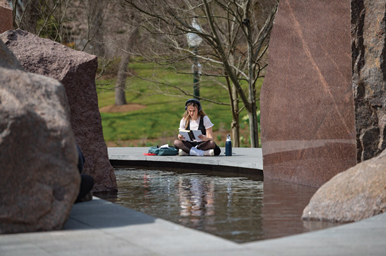
Since its April unveiling on the grassy ellipse behind the Kay Spiritual Life Center, Sudama, the monumental sculptural installation by American artist Elyn Zimmerman, has become a place for quiet reflection—in more ways than one.
“This is a major work of site-specific art that ties together architecture, art, and the land,” says Jack Rasmussen, CAS/MFA ’75, MA ’83, PhD ’94, director and curator of the American University Museum at the Katzen Arts Center. “[It’s] a reflective space—literally and figuratively. You see yourself, your surroundings, the water, the smooth polished stone in that very special space.”
Sudama is composed of five enormous granite boulders and smaller accent rocks totaling more than 450,000 pounds, which surround a crescent-shaped pool of running water. It was gifted to AU as part of the Change Can’t Wait campaign by the National Geographic Society, which commissioned the installation—then called Marabar—in 1981 for the plaza outside its DC headquarters. Zimmerman was given creative freedom over the design of her first major sculptural commission—with one caveat.
“The design was to feature rocks and water,” she recalls.
Zimmerman was inspired by the Indian temples and caves she visited in the 1970s and by E.M. Forster’s 1924 novel, A Passage to India, which describes the fictional Marabar Caves based on the real, ancient Barabar Caves in the Bihar state in the northeastern part of the country.
“The Marabar Caves, with their rough natural exteriors and highly polished interiors, became my solution to the project—not as caves but as massive, rough granite rocks with one, sometimes two, mirror-polished sides—to look as if a gigantic geode had been cracked open to straddle the 60-foot-long pool of water,” Zimmerman says.
Marabar was completed in 1984. But when the National Geographic Society announced plans for a major renovation in 2019, Zimmerman helped scout a new home for the sculpture. “[AU] seemed to be a great location,” she says. “It’s not at all the same as National Geographic. There was more sunlight, more open. It was a good fit.”
The boulders, transported to campus on flatbed trucks and put in place with cranes, needed to be reconfigured for the new space—a large oval swath of grass and trees—and its identity reimagined. Zimmerman christened it Sudama after a granite cave in India carved during the third century BC.
Linda Aldoory, dean of the College of Arts and Sciences, says the 225 tons of granite—featured in the April 3 edition of the New York Times—are already making a weighty impact on AU’s landscape and community.
“Art has the power to connect, and with the acquisition of Sudama, AU is enhancing its role as a convening arts institution in DC. Art is at the very heart of AU’s engagement with the local community. Zimmerman’s tranquil installation will provide students, faculty, staff, visitors, and the broader DC community with a peaceful and contemplative space that’s open to all.”